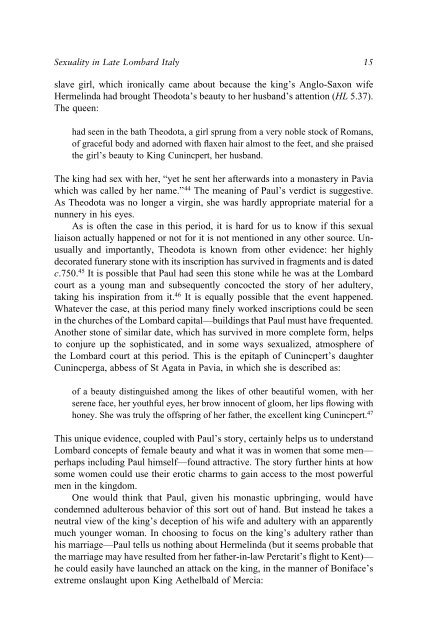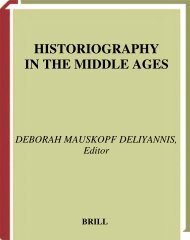Medieval Sexuality: A Casebook - Julian Emperor
Medieval Sexuality: A Casebook - Julian Emperor
Medieval Sexuality: A Casebook - Julian Emperor
You also want an ePaper? Increase the reach of your titles
YUMPU automatically turns print PDFs into web optimized ePapers that Google loves.
<strong>Sexuality</strong> in Late Lombard Italy 1511112342225672228910111232224567892022212345678930111123435678940111123222slave girl, which ironically came about because the king’s Anglo-Saxon wifeHermelinda had brought Theodota’s beauty to her husband’s attention (HL 5.37).The queen:had seen in the bath Theodota, a girl sprung from a very noble stock of Romans,of graceful body and adorned with flaxen hair almost to the feet, and she praisedthe girl’s beauty to King Cunincpert, her husband.The king had sex with her, “yet he sent her afterwards into a monastery in Paviawhich was called by her name.” 44 The meaning of Paul’s verdict is suggestive.As Theodota was no longer a virgin, she was hardly appropriate material for anunnery in his eyes.As is often the case in this period, it is hard for us to know if this sexualliaison actually happened or not for it is not mentioned in any other source. Unusuallyand importantly, Theodota is known from other evidence: her highlydecorated funerary stone with its inscription has survived in fragments and is datedc.750. 45 It is possible that Paul had seen this stone while he was at the Lombardcourt as a young man and subsequently concocted the story of her adultery,taking his inspiration from it. 46 It is equally possible that the event happened.Whatever the case, at this period many finely worked inscriptions could be seenin the churches of the Lombard capital—buildings that Paul must have frequented.Another stone of similar date, which has survived in more complete form, helpsto conjure up the sophisticated, and in some ways sexualized, atmosphere ofthe Lombard court at this period. This is the epitaph of Cunincpert’s daughterCunincperga, abbess of St Agata in Pavia, in which she is described as:of a beauty distinguished among the likes of other beautiful women, with herserene face, her youthful eyes, her brow innocent of gloom, her lips flowing withhoney. She was truly the offspring of her father, the excellent king Cunincpert. 47This unique evidence, coupled with Paul’s story, certainly helps us to understandLombard concepts of female beauty and what it was in women that some men—perhaps including Paul himself—found attractive. The story further hints at howsome women could use their erotic charms to gain access to the most powerfulmen in the kingdom.One would think that Paul, given his monastic upbringing, would havecondemned adulterous behavior of this sort out of hand. But instead he takes aneutral view of the king’s deception of his wife and adultery with an apparentlymuch younger woman. In choosing to focus on the king’s adultery rather thanhis marriage—Paul tells us nothing about Hermelinda (but it seems probable thatthe marriage may have resulted from her father-in-law Perctarit’s flight to Kent)—he could easily have launched an attack on the king, in the manner of Boniface’sextreme onslaught upon King Aethelbald of Mercia:













